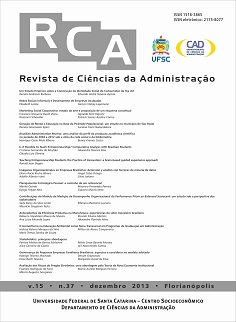Ensinando estudantes de empreendedorismo a praticar inovação: uma abordagem baseada na experiência guiada no cérebro
DOI:
https://doi.org/10.5007/2175-8077.2013v15n37p92Resumo
Este artigo apresenta um novo método para ensinar estudantes de empreendedorismo a praticar inovação e criar oportunidades de negócios de alto-impacto. O método de ensino é baseado no modelo de aprendizado através da experiência desenvolvido por Caine et al. (2009) para desenvolver as funções executivas no cérebro dos aprendizes, e na estrutura de inovação introduzida por Verganti (2009). A perspectiva cognitiva da criatividade, como explicada por Weisberg (2006), é usada para mostrar como a pratica da inovação pode ser apreendida. O modelo usado para o processo criativo está baseado na pesquisa de Wallas (1926), e em recentes descobertas neurológicas sobre os caminhos deliberados e espontâneos para criatividade (Carson, 2010). O conceito do processo effectual (Sarasvathy, 2008) prove uma abordagem para a validação das ideias de inovações radicais dos estudantes.Downloads
Publicado
Como Citar
Edição
Seção
Licença
O autor deve garantir:
- que haja um consenso completo de todos os coautores em aprovar a versão final do documento e sua submissão para publicação.
- que seu trabalho é original, e se o trabalho e/ou palavras de outras pessoas foram utilizados, estas foram devidamente reconhecidas.
Plágio em todas as suas formas constituem um comportamento antiético de publicação e é inaceitável. RCA reserva-se o direito de usar software ou quaisquer outros métodos de detecção de plágio.
Todas as submissões recebidas para avaliação na revista RCA passam por identificação de plágio e autoplágio. Plágios identificados em manuscritos durante o processo de avaliação acarretarão no arquivamento da submissão. No caso de identificação de plágio em um manuscrito publicado na revista, o Editor Chefe conduzirá uma investigação preliminar e, caso necessário, fará a retratação.
Os autores cedem à RCA os direitos exclusivos de primeira publicação, com o trabalho simultaneamente licenciado sob a Licença Creative Commons (CC BY) 4.0 Internacional.

Os autores têm autorização para assumir contratos adicionais separadamente, para distribuição não exclusiva da versão do trabalho publicada neste periódico (ex.: publicar em repositório institucional, em site pessoal, publicar uma tradução, ou como capítulo de livro), com reconhecimento de autoria e publicação inicial neste periódico.
Esta licença permite que qualquer usuário tenha direito de:
Compartilhar – copiar, baixar, imprimir ou redistribuir o material em qualquer suporte ou formato.
Adaptar – remixar, transformar e criar a partir do material para qualquer fim, mesmo que comercial.
De acordo com os seguintes termos:
Atribuição – Você deve dar o crédito apropriado (citar e referenciar), prover um link para a licença e indicar se mudanças foram feitas. Você deve fazê-lo em qualquer circunstância razoável, mas de maneira alguma que sugira ao licenciante apoiar você ou o seu uso.
Sem restrições adicionais – Você não pode aplicar termos jurídicos ou medidas de caráter tecnológico que restrinjam legalmente outros de fazerem algo que a licença permita.


